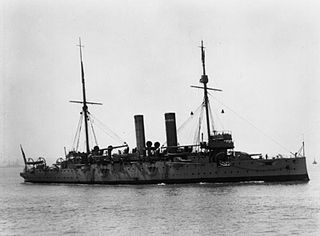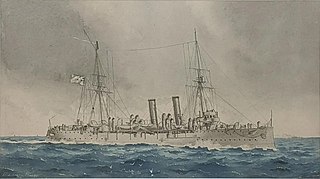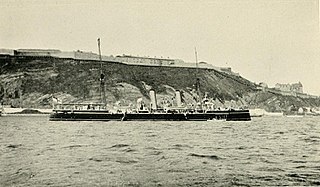
The armored cruiser was a type of warship of the late 19th and early 20th centuries. It was designed like other types of cruisers to operate as a long-range, independent warship, capable of defeating any ship apart from a battleship and fast enough to outrun any battleship it encountered.

HMS Hawke, launched in 1891, was the seventh British warship to be named Hawke. She was an Edgar-class protected cruiser. In September 1911 the Hawke collided with the ocean liner RMS Olympic. The damage smashed the Hawke's bow and damaged the stern of the Olympic.

The Pelorus-class cruiser was a "third-class" protected cruiser designed by Sir William White for the Royal Navy, based on the earlier Pearl-class cruisers. Eleven ships were ordered to this design in 1893 under the Spencer Programme, and were laid down 1896–1900. The first, HMS Pelorus, was commissioned in 1896.

HMCS Rainbow was an Apollo-class protected cruiser built for Great Britain's Royal Navy as HMS Rainbow entering service in 1892. Rainbow saw time in Asian waters before being placed in reserve in 1909. In 1910 the cruiser was transferred to the Royal Canadian Navy for service on the west coast. At the outbreak of the First World War, Rainbow was the only major Canadian or British warship on the western coast of North America. Due to age, the cruiser was taken out of service in 1917 and sold for scrap in 1920 and broken up.

HMS Revenge was one of seven Royal Sovereign-class pre-dreadnought battleships built for the Royal Navy during the 1890s. She spent much of her early career as a flagship for the Flying Squadron and in the Mediterranean, Home and Channel Fleets. Revenge was assigned to the International Squadron blockading Crete during the 1897–1898 revolt there against the Ottoman Empire. She was placed in reserve upon her return home in 1900, and was then briefly assigned as a coast guard ship before she joined the Home Fleet in 1902. The ship became a gunnery training ship in 1906 until she was paid off in 1913.

HMS Doris was an Eclipse-class protected cruiser built for the Royal Navy in the mid-1890s.

HMS Hannibal was a Majestic-class pre-dreadnought battleship built for the Royal Navy, and the sixth ship to bear the name HMS Hannibal. The ship was laid down at the Pembroke Dock in May 1894, she was launched in April 1896, and commissioned into the fleet in April 1898. She was armed with a main battery of four 12-inch (305 mm) guns and a secondary battery of twelve 6-inch (152 mm) guns. The ship had a top speed of 16 knots.

HMS Endymion was a first-class protected cruiser of the Edgar class. She served in China during the Boxer Rebellion and later in the First World War, and was sold in 1920.

HMS Essex was one of 10 Monmouth-class armoured cruisers built for the Royal Navy in the first decade of the 20th century. Upon completion in 1904 she was assigned to the 2nd Cruiser Squadron of the Channel Fleet. The ship was placed in reserve in March 1906 and recommissioned in 1909 for service with the 4th Cruiser Squadron on the North America and West Indies Station. In 1912, Essex returned home and was assigned to the Training Squadron of the Home Fleet. After a refit the following year, she rejoined the 4th Cruiser Squadron in early 1914.

HMS Berwick was one of 10 Monmouth-class armoured cruisers built for the Royal Navy in the first decade of the 20th century. She was assigned to the 2nd Cruiser Squadron of the Channel Fleet upon completion in 1903 and was transferred to the Home Fleet in 1906. She accidentally rammed and sank a British destroyer in 1908. Berwick was refitted in 1908–09 before she was transferred to the 4th Cruiser Squadron on the North America and West Indies Station later that year.

HMS Cumberland was one of 10 Monmouth-class armoured cruisers built for the Royal Navy in the first decade of the 20th century. She was assigned to the 2nd Cruiser Squadron of the Channel Fleet upon completion in 1903. After a refit in 1907–1908 she became a training ship in the Home Fleet. She was sent to West Africa after the beginning of World War I in August 1914 and captured 10 German merchant ships in September. Cumberland spent the rest of the war on convoy escort duties and patrolling for German commerce raiders. She was sold for scrap in 1921 and broken up two years later.

HMS Andromeda was one of eight Diadem-class protected cruisers built for the Royal Navy in the 1890s. Upon completion in 1899, the ship was assigned to the Mediterranean Fleet where she helped to escort a royal yacht during its cruise through the Mediterranean Sea. After a refit, she was assigned to the China Station in 1904 and returned home three years later to be reduced to reserve. Andromeda was converted into a training ship in 1913 and remained in that role under various names until 1956. That year she was sold for scrap and broken up in Belgium, the last Pembroke-built ship still afloat.

HMS Glory was a pre-dreadnought battleship of the British Royal Navy and a member of the Canopus class. Intended for service in Asia, Glory and her sister ships were smaller and faster than the preceding Majestic-class battleships, but retained the same battery of four 12-inch (305 mm) guns. She also carried thinner armour, but incorporated new Krupp steel, which was more effective than the Harvey armour used in the Majestics. Glory was laid down in December 1896, launched in March 1899, and commissioned into the fleet in November 1900.

HMS Highflyer was the lead ship of the Highflyer-class protected cruisers built for the Royal Navy in the 1890s. She spent her early career as flagship for the East Indies and North America and West Indies Stations. She was reduced to reserve in 1908 before again becoming the flagship in the East Indies in 1911. She returned home two years later and became a training ship. When World War I began in August 1914, she was assigned to the 9th Cruiser Squadron in the Central Atlantic to intercept German commerce raiders and protect Allied shipping.

HMS Pandora was a Pelorus-class cruiser of the Royal Navy. There were eleven "Third class" protected cruisers in the class, which was designed by Sir William White. While well armed for their size, they were primarily workhorses for the overseas fleet on "police" duties and did not serve with the main battlefleet.
HMS Perseus was a Pelorus-class protected cruiser of the Royal Navy. There were eleven "Third class" protected cruisers in the class, which was designed by Sir William White. They mainly served at overseas stations rather than with the main fleets.

HMS Pactolus was a Pelorus-class protected cruiser of the Royal Navy. There were eleven ""Third class"" protected cruisers in the class, which was designed by Sir William White. While well armed for their size, they were primarily workhorses for the overseas fleet on "police" duties and did not serve with the main battlefleet. She was scrapped in 1921.

HMS Prometheus was a Pelorus-class protected cruiser of the Royal Navy. Ten sister third class protected cruisers were built — designed by Sir William White. While well-armed for their size, they were primarily workhorses for the overseas fleet considered to be on police duties. She was sold for scrap in 1914.

HMS Proserpine was a Pelorus-class cruiser of the Royal Navy. There were eleven "Third class" protected cruisers in the class, which was designed by Sir William White. While well armed for their size, they were primarily workhorses for the overseas fleet on "police" duties and did not serve with the main battlefleet.

HMS Isis was an Eclipse-class protected cruiser built for the Royal Navy in the mid-1890s.




















